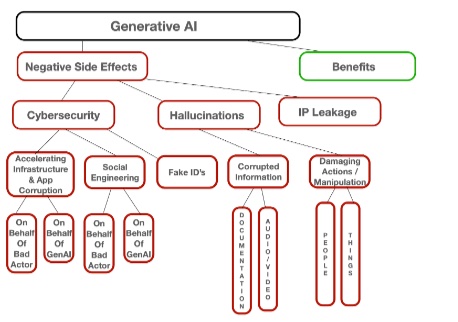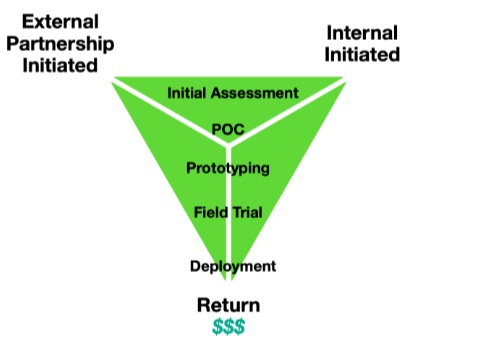Being Smart About AI: How To Better Minimize AI Risks While Maximizing Spectacular Benefits – Analysis

By Mark Cummings
Generative artificial intelligence (GenAI) has tremendous potential societal benefits. How to apply it to realize those benefits is unclear. The technology itself is evolving rapidly, becoming more and more powerful. This puts organizational leadership in a vulnerable spot. How can business, nonprofit or government organization leaders capture the benefits of this dramatic technological innovation while minimizing the risks?
At this time last year, any company that mentioned AI in its quarterly report saw its stock rise. Those days are over. Now organizations are struggling to showfinancial returnson those early investments. There are still rewards for AI investment, but this is now more discriminatory.
In the near future, organizations that have announced AI initiatives in previous quarters will see negative repercussions if they don’t report benefits from them in the current quarter. Companies that report damage from AI investments will see even worse repercussions.
This means that today’s leaders need to know how to navigate AI. They don’t need to fully understand how the technology works; they just need to know the risks inherent in applying it and how to implement an innovation ecosystem to capture real benefits. To this end, they should use the GenAI taxonomy and innovation ecosystem funnel method while practicing good communication.
Using the GenAI taxonomy as a checklist
The risks unique to GenAI derive from its negative side effects. The taxonomy below, or a simple graph of categories and their inter-relationships, illustrates these. Leaders can use it to help develop an understanding of the risks or consult it as a checklist for proposed AI projects. Which side effects are the projects subject to? How have those side effects been mitigated? What is the resulting risk/benefit ratio? They can raise many other questions as well.

Developing an AI innovation ecosystem
There are three stages of technological evolution: denial, implementation of the old paradigm with the new technology and realization of the new paradigm with the new technology. With GenAI, we are currently in the transition from stages two to three. It is difficult to predict how long this transition will take.
Stage two is the use of GenAI to enhance browser functions. What stage three will entail is unclear. During this transitional period, there will be countless concepts for how best to take advantage of the new technology. Many of them will fall apart. Some investors will try one failed endeavor and desist from further investment. More cautious investors will avoid investing altogether.
The successful leaders will implement an AI innovation ecosystem that works in a similar fashion to portfolio management — reducing risks while maximizing benefit. An innovation ecosystem recognizes that key expertise lies outside, business dynamics are well understood internally and not all good ideas will succeed.
Innovation ecosystem leaders create a culture with organizational structures, policies and procedures that work like a funnel (illustrated below). They constantly encourage and accept ideas and assess them for technical feasibility, group benefit, risk etc. They then pick the best ones for early Proof of Concept (POC) work and assess and filter based on the results. From there, the leaders choose the most promising POCs for further prototyping and assess the prototypes. After this, they select the best prototypes for field trials and assess further. Finally, the leaders determine the best field trials for full-scale deployment.

Once the stage three paradigm becomes clear, the innovation ecosystem funnel may be directed at other disruptive technologies.
Good communication is vital
From the leadership point of view, this kind of ecosystem needs organizations that communicate well. The whole group must be in sync. Staff must recognize that they are not expected to know everything. Partnering with outside organizations and individuals who bring valuable knowledge and expertise is beneficial for everyone, and should not hurt anyone’s ego.
The staff, outside investors, funders and everyone else involved must understand that failure is part of the operation. The whole purpose of the funnel is to provide a failure process that minimizes cost and maximizes potential benefits at each step.
Organizations can find success with GenAI applications if their leadership focuses their teams on mitigating inherent risks while developing an innovation ecosystem that creates a stream of potential applications. They should then filter them step by step, thus maximizing benefits while minimizing risk. They would thereby take full advantage of this dramatically developing technology.
The views expressed in this article are the author’s own and do not necessarily reflect Fair Observer’s editorial policy.
- About the author: Mark Cummings is a technologist in Silicon Valley who has a longstanding interest in how information technology can help build a healthier world. Mark has a PhD from Tohoku Imperial University, Japan, where his dissertation was “The Effects of Information Technology on Society.” He also holds an MBA from Wharton in Communications Management and a BA in Broadcasting from San Francisco State University. He has been lucky enough to be an innovator in most stages of the information revolution — both the successes and the failures. His goal for the next ten years is to help the next generation navigate through these challenging times, avoid past mistakes and achieve the full promise of our rapidly evolving technology/business/social landscape.
- Source: This article was published at Fair Observer
